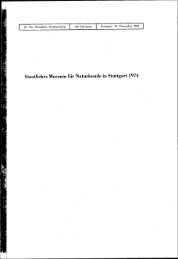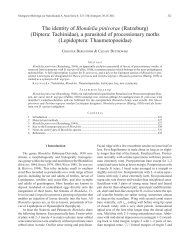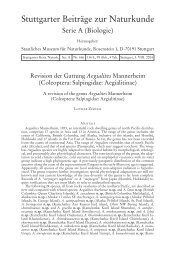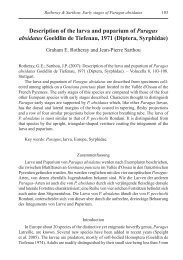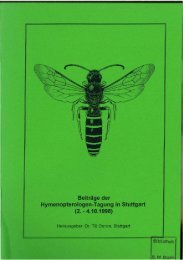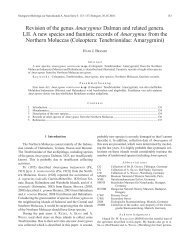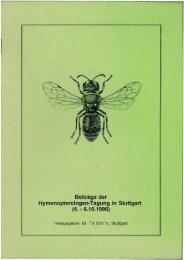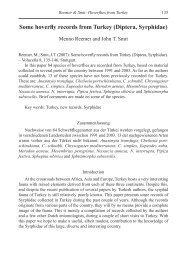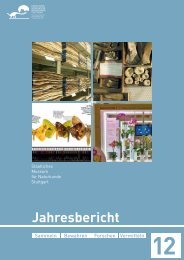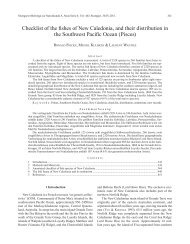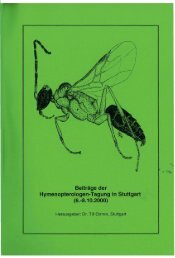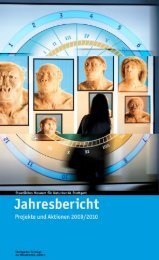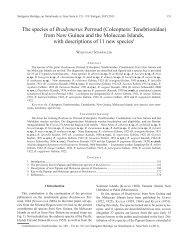Serie A (Biologie) - Staatliches Museum für Naturkunde Stuttgart
Serie A (Biologie) - Staatliches Museum für Naturkunde Stuttgart
Serie A (Biologie) - Staatliches Museum für Naturkunde Stuttgart
Create successful ePaper yourself
Turn your PDF publications into a flip-book with our unique Google optimized e-Paper software.
Bradymerus merkli n. sp. (Figs. 58, 121)Holotype (): Vietnam, Lam Dong Prov., Da Lat, 17.X.1988, leg. S. MAHUNKA & T.VÁSÁRHELYI, HNHM.Paratypes: Vietnam (labelled as Annam), Da Lat (labelled as Dalat), 23.III.–9.IV.1924,leg. R. V. DE SALVAZA, 2 ex. BMNH, 1 ex. SMNS.Etymology: Named in honor of Dr. OTTÓ MERKL (Budapest), who recognized thisspecies already in 1991 as new, for fruitful cooperation and hospitality during my visits.Description: Dorsal view see Fig. 58, dorsal side blackish without metallicshine, body length 7.5–8.5 mm. Genae not broader than eyes, frons without distinctsupraorbital keels. Last 4 antennomeres forming a club. Anterior corners of pronotumprotruding, lateral margin without distinct crenulation but sinuated, pronotaldisc with separate punctation and with distinct medial impression, between punctureswithout granules. Elytral intervals 5, 7 with keels, keels without granules, internalintervals 1–4 on disc flat, longitudinal punctures of the rows deeply imschawaller,oriental species of bradymerus 53intervals with distinct granules, granules on intervals 5, 7 sometimes confluent andforming interrupted keels. Tibiae externally without distinct keels. Aedeagus seeFig. 118.Diagnosis: Bradymerus maramagicus n. sp. belongs to the small group ofspecies with a 5-segmented antennal club around B. acutangulus from Java, B. bifurcatusfrom Vietnam, B. bocakorum n. sp. also from Mindanao and B. sumatranusn. sp. from Sumatra. These taxa can be separated by a different shape of the pronotumand a different structure of the elytra (Figs. 3, 13, 14, 53, 70) and by a differentshape of the aedeagus (Figs. 74, 81, 84, 118, 133).Bradymerus masumotoi n. sp. (Figs. 48, 119)Holotype (): Taiwan, Island Lan Hsu (= Lanyu, = Orchid Island), Tienchi, 400 m,2.V.2005, leg. K. MASUMOTO, J.-F. TSAI & W.-Z. CHEN, MNST.Paratypes: Same data as holotype, 1 SMNS. – Taiwan, Island Lan Hsu, 5.–8.VI.1986,leg. S. OSAWA, 1 NHMC.Etymology: Named in honor of Dr. KIMIO MASUMOTO (Tokyo), one of the collectors ofthe type series, for long-term and fruitful cooperation.Description: Dorsal view see Fig. 48, dorsal side blackish with a feeble metallicshine, body length 9.0–10.0 mm. Genae not broader than eyes, frons without distinctsupraorbital keels. Last 5 antennomeres forming a club. Anterior corners of pronotumprotruding, lateral margin with a feeble crenulation, pronotal disc with separatepunctation and without impression, between punctures without granules. Elytral intervalsslightly convex, alternate intervals 3, 5, 7 posteriorly with feeble keels, all intervalswithout granules. Tibiae in both sexes externally without distinct keels; inmales posterior tibia internally near the tip with a row of distinct long, yellow setae.Aedeagus see Fig. 119.Diagnosis: Bradymerus masumotoi n. sp. is extremely similar to B. aulacopterusfrom Saleyer Island adjacent of Sulawesi, but can be separated by a somewhat narrowerpronotum slightly excavated before the hind angles and by a feeble crenulationof the lateral margin (compare Figs. 12, 48), by a feeble metallic shine of the dorsalsurface (without metallic shine in B. aulacopterus) and by a somewhat differentshape of the aedeagus (Figs. 82, 119). A further argument for the validity of bothspecies might be the wide disjunct distribution (B. masumotoi n. sp. near Taiwan, B.aulacopterus near Sulawesi).



